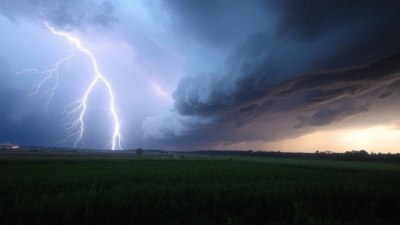Why Birds Know Something We Don’t When They All Fly Away at Once
Discover the mysteries behind synchronized bird flight and their innate abilities to sense dangers.

Birds have always fascinated humanity, not least for their incredible ability to take flight en masse, seemingly in perfect unison. This phenomenon can leave observers wondering what exactly is prompting such a sudden and coordinated response. Understanding the mystery of why birds sometimes fly away all at once involves a mix of biology, environmental factors, and innate survival instincts.
One of the most impressive aspects of bird behavior is their ability to communicate and react to their environment. Birds are equipped with advanced sensory systems that allow them to perceive subtle changes in their surroundings, often before humans can notice anything amiss. These changes could include shifts in temperature, air pressure, or even the slightest disturbances caused by approaching predators.
The Power of Instinct
Birds are often seen as creatures governed by instinct, and this instinct often plays a crucial role when it comes to their survival. Many bird species have evolved to develop heightened awareness and responsiveness to threats. When one bird senses danger, it may trigger an instinctual response to flee, which can quickly spread throughout the flock, resulting in a mass exodus.
This incredible ability to synchronize movements, even in large groups, is referred to as flocking behavior. Flocking provides several advantages for birds; it can help them avoid predators, enhance foraging efficiency, and improve navigation. The coordination seen in a flock, where they appear to move as one cohesive unit, is partly due to the simple rules of interaction that each member follows. For example, birds may maintain a certain distance from one another while aligning their flight direction with nearby flock mates.
Communication Among Birds
Although birds may have limited means of verbal communication, they are highly adept at using body language and subtle vocalizations to convey messages to each other. During periods of high alert, subtle changes in posture or a series of soft calls can serve as warnings. This non-verbal communication is essential for maintaining group cohesion and ensuring that the entire flock is aware of potential threats.
Studies have shown that certain species, such as starlings, exhibit complex communication patterns during flight. The birds alter their flight paths in response to the movements of others, enabling them to evade predators effectively. The success of these communication strategies can lead to a simultaneous flight response, where the entire flock takes off at once upon detecting danger.
Sensing Environmental Changes
Birds use various senses to detect environmental changes that may signal danger. Their acute vision enables them to perceive movement and recognize potential predators from a distance. Moreover, many species of birds have a heightened sense of hearing, allowing them to pick up nuances in their environment that would go unnoticed by other creatures.
In addition to sight and sound, birds are sensitive to changes in the Earth's magnetic field, which they use for navigation. This sensitivity may also extend to detecting natural disasters or other significant events, such as thunderstorms or earthquakes. Such heightened awareness is critical for their survival, allowing them to react swiftly to threats.
The Role of Weather Patterns
Weather patterns can significantly influence bird behavior, and it is not uncommon for certain species to take flight when a storm approaches. Birds can often sense shifts in humidity, barometric pressure, or wind patterns that precede inclement weather. In these instances, it’s not uncommon to observe a large flock taking off suddenly, as they seek to find shelter or safe locations away from the impending storm.
Moreover, changes in weather may impact the availability of food sources, prompting birds to migrate or seek alternative foraging sites. When environmental change occurs, birds must assess the situation and react accordingly to maximize their chances of survival. In this way, the ability to fly away suddenly can be a timely response to unseen threats or evolving conditions.
The Predator-Prey Relationship
The relationship between predators and prey is also vital in understanding why birds fly away all at once. When a predatory bird, such as a hawk or falcon, enters the vicinity of a flock of smaller birds, panic can ensue. The presence of these predators can trigger a survival response in the entire flock. The immediate reaction to such a threat is often to fly away en masse, which increases the odds of survival for individual birds.
By scattering in all directions, birds make it more difficult for predators to target a single individual. This ‘safety in numbers’ tactic is a common survival strategy utilized by many species. Additionally, some birds may even choose to create an alarm call, further signaling to the flock to take immediate action and flee.
Human Influence on Bird Behavior
While birds have acute instincts developed over millennia, human activity has begun to influence their behavior in unexpected ways. Urbanization, habitat destruction, and noise pollution can create stressors that prompt birds to adjust their patterns of flight. Birds in urban environments may become hyper-aware of their surroundings, leading to increased flocking behavior when they sense disruption.
Some studies suggest that heightened human presence can mask natural cues in the environment, leading birds to react in ways they might not have historically done. For instance, regular disturbances such as construction noise may disrupt normal foraging patterns, making birds more likely to flee suddenly when perceiving danger due to human activity. The need for adaptation in response to changing environments may intensify the frequency of these mass flight events.
Behavioral Adaptation and Evolution
The ability of birds to respond to threats is not static; it evolves over time. Behavioral adaptations have allowed different species to fine-tune their flight responses based on environmental and sociocultural changes. As conditions change, so too does the necessity for birds to adapt their behaviors to enhance their survival strategies.
For example, migratory birds may alter their routes based on changing weather patterns or food availability, resulting in changes in their response time to threats. These adaptations can become ingrained over generations, shaping future behaviors and responses within these populations. Over time, this evolution of instinct and learned behavior reinforces why certain bird species appear so adept at responding to dangers.
The Mystery of Synchronized Flight
The precise reasons why birds fly away all at once may remain partially shrouded in mystery, yet it is evident that their coordinated movements are closely linked to survival strategies honed over generations. Their acute senses, instinctual responses, and ability to communicate effectively with fellow flock members enable them to navigate complex environments and avoid threats. Factors such as weather patterns, predator presence, and human influence play crucial roles in shaping their behaviors. By better understanding the innate abilities of birds and their reactions to potential dangers, we can appreciate the intricate dance of avian life and the lessons it offers us about adaptation, survival, and the unseen connections within nature.











